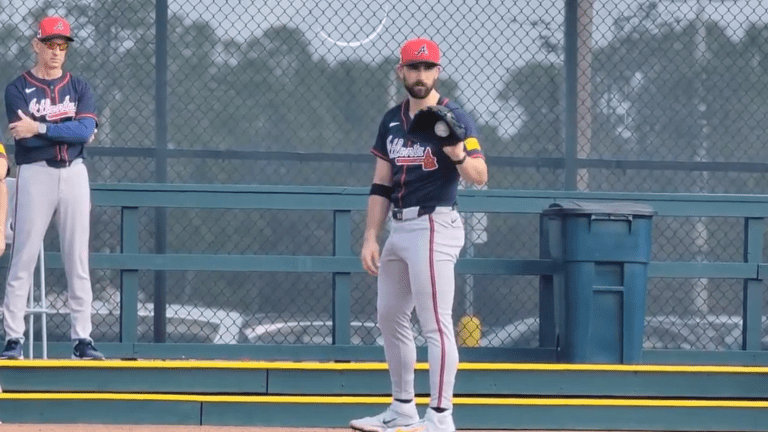New Device Could Help Slow MLB’s Tommy John Epidemic
What to make of Driveline's new PULSE Workload Monitor being seen around spring training, which could help combat pitcher injuries.

Over the past few decades, the game of baseball has gone through plenty of changes. From balls leaving the ballpark more than ever, to mechanical changes, the impact of time has greatly affected the sport. Arguably the biggest changes though, have come on the pitching side of things.
The art of pitching has shifted from having many ways to attack hitters to focusing on one thing above all else: Velocity.
Pitchers are throwing the ball harder than ever, with most pitchers being able to reach or eclipse the 95 MPH mark. Not only this, but more and more pitchers are throwing devastating breaking balls, something that was far more uncommon in the past.
While as spectators this shift has been incredibly exciting to see, there is one problem: prioritizing stuff and velocity leads to more UCL problems. As of the 2024 season, just over 36% of all pitchers at the Major League level have had Tommy John Surgery at least once.
This has been very concerning, with this same issue leading to some of baseball’s most exciting players being sidelined due to Tommy John Surgery. Last year, Shane Bieber, Shane McClanahan, Sandy Alcantara, Jacob deGrom all missed time due to the surgery.
Shohei Ohtani won an MVP as a hitter, but while he was recovering from his second elbow procedure. There could be a change on the horizon though in Major League Baseball.
As camps have begun to open over the last week, a new device has been seen on the arms of many of the game’s top prospects and top pitchers. Reds top prospect Chase Burns, and Braves ace Spencer Strider have been two of the more notable arms wearing the device.
This device is a workload monitor, a device that helps pitchers better understand how much they’re throwing, and how hard they’re throwing.
This device could be a game-changer in how MLB battles against the UCL epidemic that’s swept through the sport, and forever change how pitchers approach recovery.
What Exactly is the Workload Monitor?
The workload monitor we’ve been seeing around Spring Training Camps is a very interesting tool. The device was designed and created by Driveline, one of the top, advanced organizations that’s been helping players fine-tune their tools for years.
They’ve been ahead of the game in biomechanics, data analysis, and their ability to fix baseball players of all skill sets and ages. The PULSE Workload Monitor is another one of the products they’ve developed that’s helped pitchers greatly, joining the likes of the Plyocare balls, and more.
Although it’s small in size, the design of the Workload Monitor is sophisticated and incredibly advanced. It’s about the size and shape of a sweatband, and it’s typically worn in the upper forearm area, right above the elbow.
The Workload Monitor contains a sensor that helps measure elbow torque, arm speed, acceleration, throwing volume, and fatigue levels. These five areas will greatly help pitchers understand more about their arms, and what they’re doing daily.
It uses motion capture technology, accelerometers, and gyroscopes to track key metrics related to a pitcher’s throwing motion. The key piece of Driveline’s PULSE Workload Monitor is its ability to assess acute-to-chronic workload ratios (ACWR)—a model used in sports-related science to measure whether an athlete is building up stress normally and slowly, or overloading their arm too quickly.
Most pitchers in today’s game are under throwing programs, that specifically target how they train, strengthen, protect, and prepare themselves for each of their outings.
By measuring the five areas the Workload Monitor tracks, teams can adjust these programs, and potentially reduce each pitcher’s injury risk. This would be game-changing for all pitchers, hopefully leading to less time spent on the injured list.
While pitch counts and other methods of pitch-tracking keep track of how many throws a player makes, they don’t account for the in-depth aspects or even non-game throws. With a device like this, nothing is being left out of the equation, and every throw truly matters.
Although it may seem simple at first, the Workload Monitor is far from it. But, if this device is put into use, we could see a massive effect on the game as we know it.
How Will it Help Pitchers Stay Healthy?
Now that we understand how the Workload Monitor works, we can dive into some of the deeper questions that come with the device. The first of these questions, is how will it help pitchers stay healthy and on the field?
One of the largest factors that leads to Tommy John Surgery is pitchers overusing their arms, and not properly recovering. We often see this in the bullpen, where pitchers are overused and overworked regularly.
As I previously mentioned, the device accounts for every throw a player makes, not just in-game throws, or high-intensity action. In my opinion, this could be one of the key pieces missing in how players go about rest.
For example, if a pitcher only throws 15 pitches in a relief outing, they may still be available to throw on short rest. But, they could be forgetting the throws they made for their throwing programs, throws while warming up in the bullpen, and other areas.
This could give pitchers a false idea of the stress their arms have undergone, which could lead to more injuries. Through the Workload Monitor, these throws will all be counted, whether they have a smaller or larger impact on the player’s arm.
Driveline published a video on their YouTube channel, where they supported this idea. They asked some of their athletes how many throws they thought they made, and how many of them they thought were high-effort. Most of the pitchers in the video were far off with their guesses, supporting this idea.
The device will also signal when a pitcher is approaching dangerous levels of fatigue, allowing coaches to adjust their workload before an injury happens.
The Workload Monitor also helps pitchers better understand and create plans, rather than one-size-fits-all approaches like inning limits or pitch counts.
Some pitchers handle high workloads better than others due to their mechanics, arm strength, or training history. With data on elbow torque and fatigue, teams can design throwing programs designed to match each pitcher’s needs, ensuring they get enough rest and recovery time.
The device will also allow pitchers to begin to see trends that could be indicating a problem.
For example, a gradual decline in arm speed or acceleration could indicate fatigue, and avoiding sudden spikes in intensity could help pitchers avoid injuries. If teams and players notice these trends early enough, they could prevent injuries before it’s too late.
Better understanding your body, and what it can withstand will be crucial to pitchers all across the game. With no one specific approach to rest or arm care, you can target the individual differences in all arms. That way, your pitchers who can pitch on short rest safely can still do so, while your pitchers who need longer rest can also get what they need.
When taking all of these ideas into account, you can begin to see how the Workload Monitor can have a huge impact on keeping pitchers healthy, despite its relatively simple nature.
Will This Ever Be Used In-Game?
After doing my deep dive into the PULSE Workload Monitor, I think it would be wise for MLB to consider allowing the in-game usage of this device. Although it may take a long time to convince MLB to sign off on this idea, it could be a great way to combat injuries, and I think that could lead to more willingness.
It is important to note that MLB has been incredibly strict in terms of on-field devices, and wearables for plenty of years. Most notably, umpires looked at a Blast Motion Sensor casing that Reds star shortstop Elly De La Cruz used on the end of his bat.
While this ended up just being a personal preference thing for De La Cruz, hitting without the sensor inside the case, it shows MLB’s lack of willingness to let its players use technology like this in-game.
MLB has notably also been very strict on the sleeves that pitchers wear, the colors of their equipment, and more. This could mean that MLB would be more strict on a visible, wearable device like the Workload Monitor being worn on a pitcher’s throwing arm.
If MLB were to allow the usage of the device in-game, the impact wouldn’t just be in better understanding of the damage done to a player’s arm, but also how they manage games.
For example, if a manager has real-time updates from the player’s Workload Monitor and notices a deviation in the player’s regular metrics that indicates fatigue or another problem, they could be more inclined to pull them from the game.
Even if MLB didn’t allow pitchers to wear the devices in-game, managers could still make similar decisions if their players all wore them while warming up in the bullpen. So, not only would pitchers better avoid injuries, but, managers could use this to make more informed decisions.
Will the Device Help Combat the Tommy John Epidemic?
In my opinion, this device should help combat the Tommy John Epidemic MLB has been facing over the past few seasons.
If pitchers regularly wear their devices and listen to what the data is telling them, then this should have an impact on how they go about their daily routines, limiting the risk of injury.
From better understanding your body, to making smarter decisions in a player’s training routine, this device will certainly play a role in avoiding injuries. By not pushing their bodies, making informed decisions about rest, and more, pitchers will be in better positions for their health.
While it’s tough to know how significant of an impact this will have on the prevention of significant arm injuries without more implementation, we should be paying close attention to the teams that begin implementing these devices, and what happens to their pitchers.
So far this spring, it appears as though the main team to watch will be the Cincinnati Reds, as more of their players have been seen wearing these devices than any other team in the league. From Nick Martinez, Nick Lodolo, and Chase Burns, their pitchers have been prioritizing this in Spring Training.
Sick Burns bro@ChaseBurns20 pic.twitter.com/RfsHKYEHvt
— Cincinnati Reds (@Reds) February 10, 2025
One thing’s for certain though, MLB’s Tommy John epidemic is something the league should be taking extremely seriously. If the Workload Monitor does help prevent Tommy John Surgery, then let’s hope more pitchers begin wearing the device every day.
